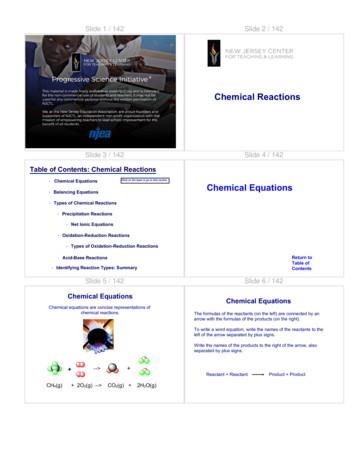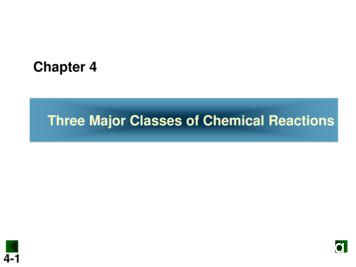Chap 06A-Chemical Reactions
4/19/15Chapter 6AChemicalReactions1CHAPTER OUTLINE § § § § § § § § Chemical ReactionsChemical EquationBalancing EquationsTypes of Chemical ReactionsDouble Replacement ReactionsOxidation-Reduction ReactionsRedox in Biological SystemsActivity Series of Metals21
4/19/15CHEMICAL REACTIONS q A chemical reaction is a rearrangement ofatoms in which some of the original bonds arebroken and new bonds are formed to givedifferent chemical structures.q In a chemical reaction, atoms are neithercreated, nor destroyed.q A chemical reaction, as described above, issupported by Dalton’s postulates.3CHEMICAL REACTIONS a chemical reaction, atoms are neither6Inoxygenatoms 6 oxygen atomscreated, nor destroyed42
4/19/15CHEMICAL REACTIONS q A chemical reaction can be detected by one ofthe following evidences:1. Change of color (formation of a solid)2. Formation of a gas3. Exchange of heat with surroundings5CHEMICAL EQUATIONS q A chemical equation is a shorthand expressionfor a chemical reaction.Word equation:Aluminum combines with ferric oxide to formiron and aluminum oxide.Chemical equation:Al Fe2O3 Fe Al2O363
4/19/15CHEMICAL EQUATIONS q Reactants are separated from products by anarrow.Al Fe2O3 Fe Al2O3q Coefficients are placed in front of substancesto balance the equation.2 Al Fe2O3 2 Fe Al2O3Subscripts7CHEMICAL EQUATIONS q Reaction conditions are placed over the arrow.ΔAl Fe2O3 Fe Al2O3heatq The physical state of the substances areindicated by the symbols (s), (l), (g), (aq).Δ2 Al (s) Fe2O3 (s) 2 Fe (l) Al2O3 (s)solidliquid84
4/19/15BALANCING EQUATIONS q A balanced equation contains the same numberof atoms on each side of the equation, andtherefore obeys the law of conservation ofmass.q Many equations are balanced by trial anderror; but it must be remembered thatcoefficients can be changed in order to balancean equation, but not subscripts of a correctformula.9BALANCING EQUATIONS q The general procedure for balancing equations is:Write the unbalanced equation:CH4 O2 CO2 H2OMake sure theformula for eachsubstance is correct105
4/19/15BALANCING EQUATIONS q The general procedure for balancing equations is:Balance by inspection:CH4 O2 CO2 H2O1CCount and compareeach element on4Hboth sides of theequation2 O 1C!2H!3O11BALANCING EQUATIONS q Balance elements that appear only in onesubstance first.Balance H4 H present oneach sideCH4 O2 CO2 H2O1 CH4 O2 CO2 2 H2O126
4/19/15BALANCING EQUATIONS Balance OWhen finally done, checkfor the on4 O presentsmallest coefficients possibleeach side1 CH4 O2 CO2 2 H2O1 CH4 2 O2 CO2 2 H2O13Examples: 2 AgNOAgNO33 HH22SS AgAg22SS 2HNOHNO3 32 Al(OH)Al(OH)3 3 3 H2SO4 Al2(SO4)3 6H2HO2OFeFe4HH22 3FeFe H42HO2O3O3O4 4 2 C4CH410H10 13 OO22 8COCO102 2 H2OH2O147
4/19/15CONCEPT CHECK q If red spheres represent oxygen atoms and bluespheres represent nitrogen atoms, write abalanced equation for the reaction shown below.2 NO O2 2 NO215TYPES OF CHEMICAL REACTIONS q Chemical reactions are classified into five types:1. Synthesis or combination2. Decomposition3. Single replacement4. Double replacement5. Combustion168
4/19/15SYNTHESIS or COMBINATION q In these reactions, 2 elements or compoundscombine to form another compound.A B AB17DECOMPOSITION q In these reactions, a compound breaks up to form2 elements or simpler compound.AB A B189
4/19/15SINGLE REPLACEMENT q In these reactions, a more reactive elementreplaces a less reactive element in a compound.A BC B AC19DOUBLE REPLACEMENT q q TheIn thesecationreactions,from onetwocompoundcompoundsreplacescombinethe cationtoinformanothertwo newcompound.compounds. AB CD AD CB2010
4/19/15COMBUSTION q A reaction that involves oxygen as a reactantand produces large amounts of heat is classifiedas a combustion reaction.CH4 (g) 2 O2 (g) CO2 (g) 2 H2O (g)21Examples: Classify each of the reactions below:1.2.3.4.DecompositionMg CuCl2 MgCl2 CuCaCO3 CaO CO2SynthesisSinglereplacement2 HCl Ca(OH)2 CaCl2 2 H2Oreactive4 FeMg 3isOmoreFe2O3 than Cu2 2Double replacement2211
4/19/15DOUBLE REPLACEMENT REACTIONS q Double replacement reactions can be subdividedinto one the following subgroups:1. Precipitation:formation of a solid2. Neutralization: formation of water3. Unstable product: formation of a gas23PRECIPITATION REACTIONS q In these reactions one of the products formed is aninsoluble solid called a precipitate.q For example, when solutions of potassium chromate,K2CrO4 , and barium nitrate, Ba(NO3)2 , arecombined an insoluble salt barium chromate,BaCrO4 , is formed.K2CrO4 (aq) Ba(NO3)2 (aq)BaCrO4 (s) 2 KNO3 (aq)precipitate2412
4/19/15NEUTRALIZATION REACTIONS q The mostSaltsare onanddonatedbases isfrom thecalledneutralization.base and the anion donated from the acid.q In thetheselaboratory,reactions anneutralizationacid combinesreactionswith a arebase toform a saltobservedbyandan increasewater. in temperature(exothermic reaction).HCl (aq) NaOH (aq) æ æÆ NaCl (aq) H 2O (l)AcidBaseSalt25UNSTABLE PRODUCT REACTIONS q Some chemical reactions produce gas because oneof the products formed in the reaction is unstable.q Two such products are:Carbonic acid: H2CO3 (aq) CO2 (g) H2O (l)Sulfurous acid: H2SO3 (aq) SO2 (g) H2O (l)2613
4/19/15UNSTABLE PRODUCT REACTIONS q When either of these products appears in a chemicalreaction, they should be replaced with theirdecomposition products.2 HCl Na2CO3 2 NaCl H2CO32 HCl Na2CO3 2 NaCl CO2 (g) H2O (l)27Examples: Complete and balance each neutralization reactionbelow:2 HNO3 Ba(OH)2 Ba(NO3)2 2 H2OH2SO4 2 NaOH Na2SO4 2 H2OHC2H3O2 KOH KC2H3O2 H2O2814
4/19/15OXIDATION-REDUCTION REACTIONS q ReactionsInan oxidation-reductionknown as oxidationreaction,and reductionelectrons anceapplicationsto another.in ourq everydayIf one substancelives. loses electrons, another substanceq mustRustinggainofelectrons.a nail or the reaction within your carbatteries are two examples of redox reactions.29OXIDATION-REDUCTION REACTIONS q Oxidation is defined as loss of electrons, andreduction is defined as gain of electrons.q One way to remember these definitions is to usethe following mnemonic:q Oxidation Is Loss of electronsOILReduction Is Gain of electronsRIGCombination, decomposition, single replacementand combustion reactions are all examples ofredox reactions.3015
4/19/15OXIDATION-REDUCTION REACTIONS q InForgeneral,example,atomsin theofformationmetals loseofelectronscalcium tosulfideformcations,fromcalciumand areandthereforesulfur oxidized, while atoms ofnon-metals gaintoCaSform anions, and areCaelectrons Stherefore reduced.CaCa2 2 e-S 2 e-S2-OxidationReductionq Therefore, the formation of calcium sulfide involvestwo half-reactions that occur simultaneously, one anoxidation and the other a reduction.31OXIDATION-REDUCTION REACTIONS q Similarly, in the reaction of magnesium metal withhydrochloric acidMg 2 HClMgMgCl2 H2Mg2 2 e-2 H 2 e-H2OxidationReductionIn every oxidation-reduction reaction, the number of electronslost must be equal to the number of electrons gained.3216
4/19/15OXIDATION-REDUCTION IN BIOLOGICAL SYSTEMS q Many important biological reactions involveoxidation and reduction.q In these reactions, oxidation involves addition ofoxygen or loss of hydrogen,and reduction involvesOxidationloss of oxygen or gain of hydrogen.(loss ofq For example, poisonous methylalcohol ishydrogen)metabolized by the body by the following reaction:CH3OHmethyl alcoholH2CO 2H formaldehyde33OXIDATION-REDUCTION IN BIOLOGICAL SYSTEMS q The formaldehyde is further oxidized to formicacid and finally carbon dioxide and water by theOxidationfollowing reactions:(gain ofoxygen)2 H2CO O22H2CO2formaldehyde2 H2CO2 O2formic acidCO2 H2Oformic acid3417
4/19/15OXIDATION-REDUCTION IN BIOLOGICAL SYSTEMS q In many biochemical oxidation-reduction reactions,the transfer of hydrogen atoms produces energy inthe cells.q For example, cellular respiration is an oxidationreduction process that transfers energy from thebonds in glucose to form ATP.C6H12O6 6 O26 CO2 6 H2O ATP Heat35OXIDATION-REDUCTION IN BIOLOGICAL SYSTEMS Loss of hydrogen atoms(becomes oxidized)C6H12O6Glucose6 O26 CO26 H 2OGain of hydrogen atoms(becomes reduced)ATP Heat18
4/19/15OXIDATION-REDUCTION IN BIOLOGICAL SYSTEMS q The oxidation of a typical biochemical molecule caninvolve the transfer of hydrogen atoms to a protonacceptor such as coenzyme FAD to produce itsreduced form FADH2.37REDOX IN BIOLOGICAL SYSTEMS q In summary, the particular definition of oxidationreduction depends on the process that occurs in thereaction.q A summary of these definitions appears below:3819
4/19/15Example 1: Linoleic acid, an unsaturated fatty acid, can be convertedto a saturated fatty acid by the reaction shown below. Islinoleic acid oxidized or reduced in this reaction?C18H32 O2 2 H2C18H36 O2Gain ofReductionhydrogen39Example 2: The reaction of succinic acid (C4H6O4) provides energyfor the ATP synthesis and is shown below:C4H6 O4FAD 2 H C4H4 O4 2 H FADH2a) Is succinic acid oxidized or reduced? oxidationLoss ofb) Is FAD oxidized or reduced? reductionhydrogenGain ofhydrogen4020
4/19/15ENZYMES IN BIOLOGICAL SYSTEMS q In biochemical reactions, enzymes are necessary tooxidize glucose and other foods.q For example, oxidationof glucose involves thetransfer of hydrogenatoms and electrons toan enzyme, such as NAD to produce its reducedform NADH.41ENZYMES IN BIOLOGICAL SYSTEMS q Similarly, oxidation of methanol involves transferof 2 hydrogen atoms and 2 electrons to NAD toform the reduced form NADH.4221
4/19/15ENZYMES IN BIOLOGICAL SYSTEMS q Molecules such as NAD are called “electroncarriers” since they carry electrons in their reducedform.q The electron carriers collectively are called electrontransport chain.q As electrons are transported down the chain, ATPis generated.43ENZYMES IN BIOLOGICAL SYSTEMS 4422
4/19/15ACTIVITY SERIES OF METALS q Activity series is a listing of metallic elements indescending order of reactivity.q Hydrogen is also included in the series since itbehaves similar to metals.q Activity series tables are available in textbooksand other sources.45ACTIVITY SERIES OF METALS q Elements listed higher willdisplace any elements listed belowthem.q For example Na will displace anyelements listed below it from oneof its compounds.2 Na (s) MgCl2 (aq) 2 NaCl (aq) Mg (s)Na (s) AgCl (aq) NaCl (aq) Ag (s)4623
4/19/15ACTIVITY SERIES OF METALS q Elements listed lower will notdisplace any elements listed abovethem.q For example Ag cannot displaceany elements listed above it fromone of its compounds.Ag (s) CuCl2 (aq) No ReactionAg (s) HCl (aq) No Reaction47Example 1: Use activity series to complete each reaction below.If no reaction occurs, write “No Reaction”.Pb (s) 2 HCl (aq) PbCl2 (aq) H2 (g)MetalsPb is morereactivethan HFeNiSnPbHCuAg4824
4/19/15Example 2: Use activity series to complete each reaction below.If no reaction occurs, write “No Reaction”.Zn (s) MgCl2 (aq) No ReactionZn is lessreactivethan MgMetalsNaMgAlZnFeNi49Example 3: Use activity series to complete each reaction below.If no reaction occurs, write “No Reaction”.Ni (s) CuCl2 (aq) NiCl2 (aq) Cu (s)MetalsNi is morereactivethan CuFeNiSnPbHCuAg5025
4/19/15Example 4: Use activity series to complete each reaction below.If no reaction occurs, write “No Reaction”.3 Mg (s) 2 AlCl3 (aq) 3 MgCl2 (aq) 2MetalsAl (s)Mg is morereactivethan AlNaMgAlZnFeNi51THE END5226
CHEMICAL! REACTIONS! " A chemical reaction can be detected by one of the following evidences: 1. Change of color (formation of a solid) 2. Formation of a gas 3. Exchange of heat with surroundings 6 CHEMICAL! EQUATIONS! " A chemical equation is a shorthand expression for a chemical reaction. Word equation: Aluminum combines with ferric oxide to form
Preparing the living compartment (inside)P.4 Chap. III CArrYInG PASSEnGErS P.5 Chap. IV LoADS AnD LoADED wEIGHt P.6 Chap. V wInDowS AnD SKYLIGHtS P.8 Chap. VI DrIVInG P. 10 Chap. VII tYrES P.11 Chap. VIII SIGnALInG, lights P.12 Chap. IX PArKInG mAnEuVErS P. 14 Chap. X tHE CAmPEr DrIVEr'S CHArtEr P. 16 Chap. XI oPErAtIon oF APPLIAnCES P.17
Chemical Reactions Slide 3 / 142 Table of Contents: Chemical Reactions · Balancing Equations Click on the topic to go to that section · Types of Chemical Reactions · Oxidation-Reduction Reactions · Chemical Equations · Net Ionic Equations · Types of Oxidation-Reduction Reactions · Acid-Base Reactions · Precipitation Reactions
MINISTRY Of FINANCE 01 O i I Companies ( Chap 75: 04) 02 Other Companies ( Chap 75: 02) 03 Individuals (Chap 75: 01) 04 Withholding Tax ( Chap 75: 01) 05 Insurance Surrender Tax ( Chap 75: 01) 07 Business Levy ( Chap 75: 02) 09 Hea I th Surcharge ( Chap 75: 05) Total Estimates 2022 Revised Estimates 2021 .
Lesson Overview Chemical Reactions and Enzymes Chemical Reactions and Enzymes. Lesson Overview Chemical Reactions and Enzymes Chemical Reactions A chemical reaction is a process that changes , or transforms, one set of chemicals into another by changing the
Chemical reactions called _ reactions give off heat. 5. Other reactions called _ reactions absorb heat and cool the immediate environment. 6. True or False. During all chemical reactions, a chemical change takes place that produces new substances with properties different than those of the original substances. .
The Major Classes of Chemical Reactions. 4.6 Elements in Redox Reactions 4.1 The Role of Water as a Solvent 4.2 Writing Equations for Aqueous Ionic Reactions 4.3 Precipitation Reactions 4.4 Acid -Base Reactions. 4.5 Oxidation -Reduction (Redox) Reactions 4.7
Types of Reactions There are five main types of chemical reactions we will talk about: 1. Synthesis reactions 2. Decomposition reactions 3. Single displacement reactions 4. Double displacement reactions 5. Comb
During the American Revolution both the American Continental Army and the British Army had spies to keep track of their enemy. You have been hired by the British to recruit a spy in the colonies. You must choose your spy from one of the colonists you have identified. When making your decisions use the following criteria: 1. The Spy cannot be someone who the Patriots mistrust. The spy should be .























